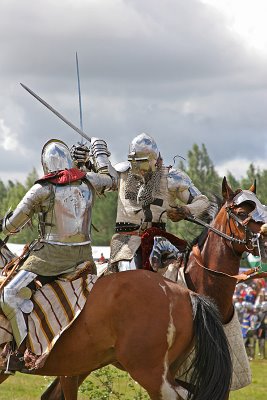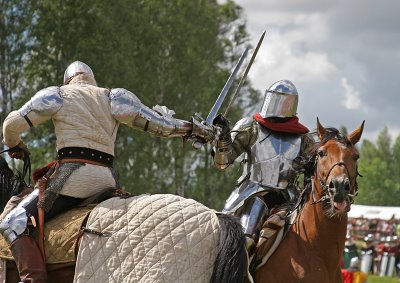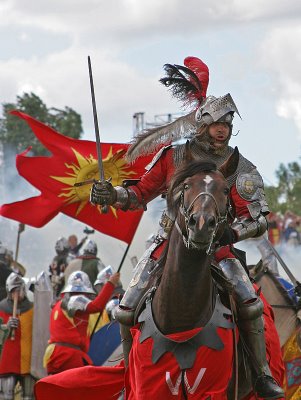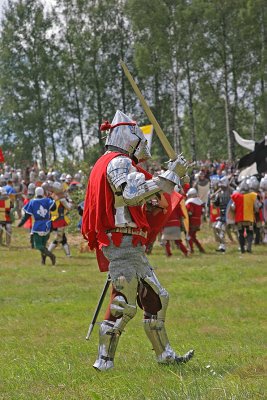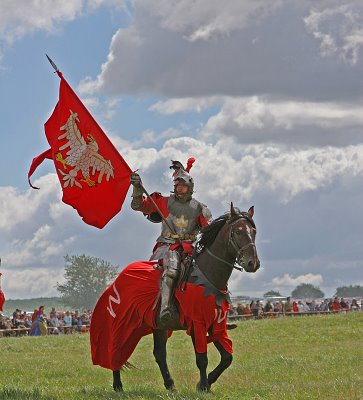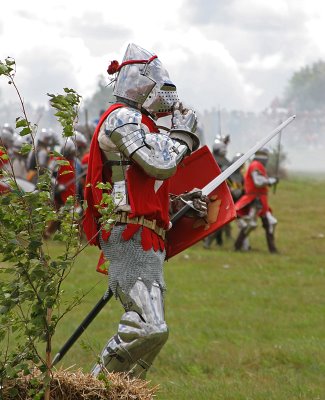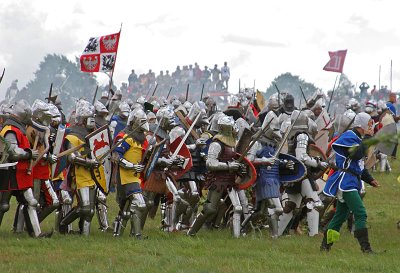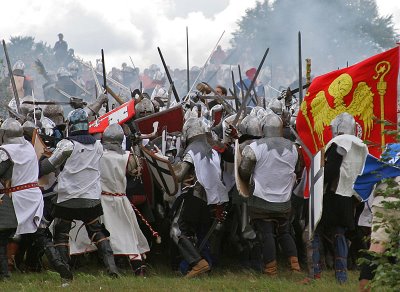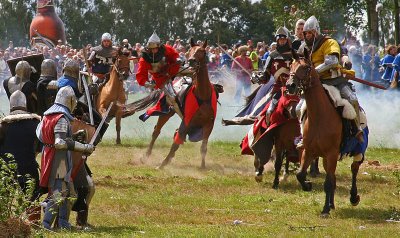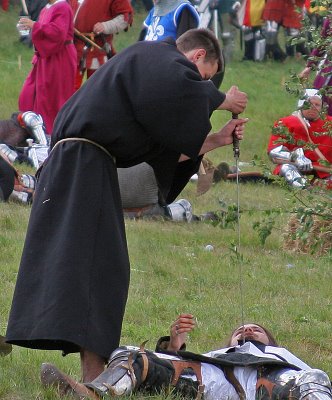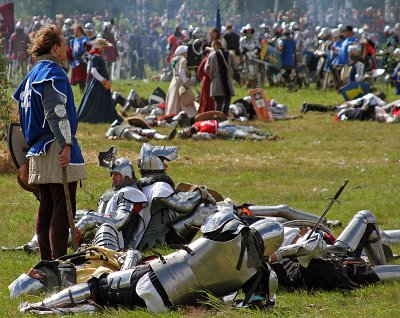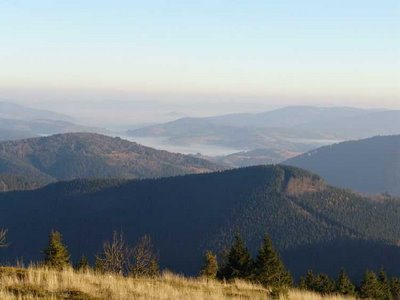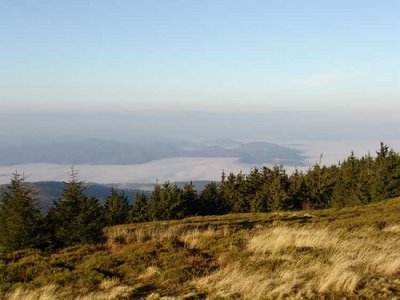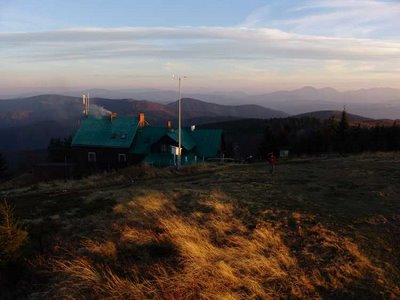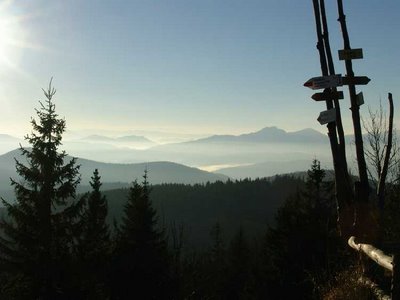 Above - MALBORK Castle today -the head quarter of teutonic Knights today ( northern Poland)
Above - MALBORK Castle today -the head quarter of teutonic Knights today ( northern Poland) Above- one of numerous paintings about Battle of Grunwald
Above- one of numerous paintings about Battle of Grunwald
Hi,
in this entry of mine I would like to write a bit about one of the most famous battles of medieval Europe that took place in Poland on the fields near Grunwald in Poland in 1410.
Moreover I would like to notice that EVERY YEAR Polish knights gather and try to commemorate next anniversary of the Battle by pretending the batle that took place then.
I think it is a very interesting idea and I will write you more about Battle of Grunwald in 2006.
In the meantime, however, read more about what I found on the Net dealing with this subject. Next posts soon.
Probably I should write more about WorldCup 2006 that was won by ITALIAN. Second place took Frenchmen, bronze medal for Germans and fourth were Portugals. Zinedine Zidane (France) made a head-hit in the breast of Italian player that seems to be much more famous that the victory of Italians. Now everywhere we can see requests like "do it like Zidane" and countless insinuations about what was told to Zidane that he had answered with such aggresiveness. etc:( Generally pitiful and waste of time to relate it:(
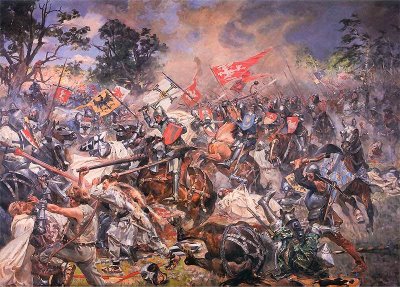
Above - another picture about the battle of Grunwald
OK - and here is a text about Grunwald battle:
It was 1226 when the Polish Duke of Mazowsze, Konrad Mazowiecki invited the Palestine - based Teutonic Order into the lands of Chelmno, on the river Wisla (Vistula), expecting the Order's help in their struggles against pagan Prussians. Grand Master Hermann von Salza had brought his first German knights to Poland that same year, with the presumed intention of staying a year or two. Nearly two hundred years later they owned most of the Baltic coast, including the lands of Latvia and Estonia, and showed every intention of soon controlling Lithuania, Poland and Russia.
The Teutonic Knights achieved excellent diplomatic relations with other western countries, and developed a particularly good relationship with the papacy. They seemed destined to control and occupy the whole of Eastern Europe, and acted under a commission signed by the Pope, ordering them to Christianise the pagan lands in the Baltic Region. No matter how they behaved, they could always claim that they acted under Papal authority, and with the approval of God Himself.
Their first Christianising mission in the 13th century involved the Prussians, a tribe which controlled the amber trade along the Baltic. The Teutonic knights dealt with them in a most effective way: they eliminated them almost completely. Those who remained alive were forbidden to marry so that no further Prussian children would be forthcoming. Centuries later, when Prussia was a proud and famous name among Europeans, there was hardly a true Prussian alive, and the archaic Prussian language slowly died out under Teutonic occupation.
The Teutonic Knights continued their occupations and captured Pomorze (1308-1309), Chelmno, Kujawa, Dobrzyn, and Kalisz in Poland. Every time Polish land was captured, the population was massacred, and Germans were brought to live in the captured lands. For example, in 1308 when the knights marched on Gdansk singing "Jesu Christo Salvator Mundi" they killed most of the Polish citizens, about ten thousand in number, and replaced them with German immigrants, who gave them full allegiance.That same year the biggest, most powerful fort in Europe was finished,Malbork - built by the Knights in the occupied Prussian area.
The 14th century Order's attacks were mainly against the pagan Lithuanian State, combining the mission to spread Christianity, and the desire to capture Lithuanian lands, especially the area around Zemaitija (Zmudzi or Samogitia). The Knights of the Teutonic Order needed reinforcements to fight effectively in this region. Well-armed knights from France, England, Luxembourg, Austria, Hungary, Bohemia and the Low Countries arrived every year to participate in "Lithuanian Crusades". Although these mercenaries were never allowed to become full members of the Teutonic Order, they were granted an honourable affiliation, and fought alongside the Teutonic Knights. For two centuries, the Krzyzacy attacked, but the Lithuanians resisted hard.
In 1385 Lithuania entered into a union with the Polish Kingdom, and the following year The Grand Duke of Lithuania, Vladyslav Jogaila, married the Queen of Poland and acceded to the Polish throne. He became a Christian, and changed his name to Wladyslaw Jagiello.
Jagiello brought Christianity to the last pagan European country, Lithuania in 1387. It was understood by both nations that only by uniting, could they handle the powerful Knights. It was obvious that war could not be avoided between the two enemies.
In 1401 Jagiello left the title of Grand Duke of Lithuania to his cousin Vytautas the Great, so that he (Jagiello), could be free to concentrate on Polish affairs. King Jagiello and Lithuanian Grand Duke Vytautas the Great (Witold) had difficulty in reconciling with the occupation of their lands, the massacres of innocent citizens in villages near the Polish-Lithuanian-Teutonic borders. They were also conscious that the Order was gaining power year by year, preparing to conquer Eastern Europe. There was peace for a time after the union of Lithuania and Poland, but in 1398 the Teutonic knights invaded Lithuanian and Polish territory, and occupied the areas of Zemaitija (Zmudzi), Santok, and Drezdenko.The Polish-Lithuanian State considered Zemaitija to be part of its own territory, of course, and a cold war started between the Polish-Lithuanian State and the Teutonic Order.
The Poles and Lithuanians realised they were not strong enough to oppose the terror which the knights visited on the far fringes of their land, and had to bear the invasions and insults in silence.
But on 14 August 1409, Teutonic Grand Master Ulrich von Jungingen declared war on the Polish-Lithuanian State. He also proposed an armistice with his neighbours, as neither side was ready for war, and for the time being, Jagiello and Vytautas accepted that.It was obvious that this state of affairs could not last for ever, and Jagiello said:
"Next year we either conquer the Crossed Knights or we perish as a nation, and as individuals"
The truce was to last from 8 October 1409 until sunset on 24 June 1410. During that time Jagiello sent spies to the occupied lands to learn all they could about the powerful enemy. All across Poland and Lithuania that winter of 1409, preparations were made for military action. Pikes were gives new shafts, swords were sharpened or annealed if they had lost their temper, horses were shod and armour was closely fitted. But the same happened in the lands occupied by the Teutonic Knights, assembling from the farthest reaches of their territory, and from France and England and Holland as well.
Both sides understood that a titanic battle would follow.
In the meantime Jagiello sent some of his own people to Kiev, seeking help from the Tartars, who agreed to send 1500 cavalrymen after May 1410. The Bohemians would send 3000 men under the leadership of Jan Sokol, and help would also come from Moldova and Russia, since they understood the importance of this battle. In December 1409, Jagiello, Vytautas, and Dzala-ed-din, the leader of Tartars, met in Brzesc Litewsk, and formulated a plan of how to go to Malbork, and crush the Teutonic Order once and for all.
In the second week of June 1410, only eleven days before the armistice was due to end, the Polish forces were surprised by the arrival of three Teutonic Knights in full armour and bright trappings. They sought to speak with King Jagiello, proposing to him that the armistice should be extended for three weeks. Jagiello asked why, and the knights answered that knights from other nations of Europe wished to participate in the crusade, and that honour should not be denied to them.
Jagiello accepted that proposal, not out of consideration for the Order, but because these extra days would be useful for better preparing his army.
Soon Jagiello and Vytautas the Great with their armies and their colours assembled in Mazowsze on 2 July, at Czerwinsk on the river Wisla. On July 3 they started moving towards the enemy. On 8 July the huge army of Jagiello and Vytautas crossed the borders, with the intention of marching against Malbork. But Grand Master Ulich von Jungingen, a brilliant leader and fearless warrior, tried to trap the enemy. He knew from his own spies where the enemy would pass, and positioned his Krzyzacy on the opposite side of the river from Jagiello's army, near the small village of Drwecy. But the Polish King and Vytautas did not want to fight in that area, where the Krzyzacy would have an advantage, and decided to approach Malbork from the other direction, via the occupied town of Dabrowno.
The Krzyzacy would take another route, to head them off, with the intention of opposing the huge enemy army in Grunwald, or in Frygnowo, or Rychnowo. On 13 July the Polish-Lithuanians reached the city of Dabrowno, occupied by the Krzyzacy, and now populated by German citizens. Within a few hours of storming the city, the Poles and Lithuanians captured it. No defending Crusader managed to survive. They were all killed. So strong was the hate for the Krzyzacy, and the feeling of revenge in the army of Poles and Lithuanians, that the town was totally burned, in the full knowledge that this would be seen by Krzyzacy who were kilometres away, following the army of Vytautas and his cousin. The fire and heavy smoke was indeed seen that night by the Grand Master and his army, who observed that Dabrowno had been captured and burned, and he predicted that a wild battle could not be avoided? We should not let them cross our borders, said one Crusader Commander to his Grand Master.?
The Krzyzacy watched the town burn without saying anything.
The huge army of Poles and Lithuanians left Dabrowno before dark on 15 July, and by sunrise they had reached Lake Lubien. This time the Grand Master found the army of Jagiello and Vytautas, and for second time planned to oppose the enemy, on Tuesday 15 July, at the villages of Grunwald, Stebark and Lodwigowo near Lake Lubien. The land around here was heavily forested with wood suitable for concealing the Polish-Lithuanian army.
When the sun rose on that fateful day, 15 July, one could have imagined all Europe holding its breath to see who would win the titanic battle that had so long been expected. Everyone understood its tremendous significance, since the winner would occupy all of Eastern Europe.
The Krzyzacy positioned their headquarters near the little village of Grunwald, while some three miles distant, the Polish and Lithuanian Commanders had their headquarters near to the equally small village of Stebark (Tannenberg).
In subsequent history the Poles would call this the Battle of Grunwald, the Lithuanians the Battle of Zalgiris, and the Germans and other western allies, the Battle of Tannenberg.
When the priest finished on the Polish-Lithuanian side, Jagiello spoke to the Commanders:
"Brothers, we move this day to end the tyranny which has oppressed our lands. The Krzyzacy will come against us with the blessing of the church, and the cross of Christ upon their bosoms. But they also come clothed in lies. We ride forth with trust in our banner, and the deep love of Jesus Christ as our shield. To Freedom! To victory!"
Soon a Commander asked the King when they would move into a battle position, and the King simply replied: -"We don't"
Jagiello was 60 years old that day. He was senior to any of his commanders or to any enemy leaders, and together with his equally capable cousin Vytautas the Great, made a plan which would give them every possible advantage against the Krzyzacy. The disadvantages of Jagiello's and Vytauta's army were many and a small mistake could destroy once for all Polish-Lithuanian State.
The Poles had provided a formidable army of 18.000 knights, 11.000 retainers and 4000 foot soldiers, to which must be added 11.000 Lithuanian knights and foot soldiers, 1100 Tartars and about 6000 Bohemians, Russians, Moravians and Moldavians who came to help the Polish-Lithuanian State. But only a precious few were heavy cavalry. Most of the Lithuanian and Polish foot soldiers were armed with clubs, and their equipment was inferior to that of the Krzyzacy.
The Krzyzacy could assemble that day 21.000 excellent heavy cavalrymen, 6000 massively armed infantry, and 5000 servants trained in battle, and better-armed than most of the Lithuanian and Polish foot soldiers. Most of these Krzyzacy would be Teutonic Knights/Germans, but from all Western Europe knights had come to help their brothers against the "pagan" Lithuanians (some of them were indeed still pagans), and the Poles who dared to support the pagans instead of the Christians. English, French, Hungarians, Austrians, Bavarians, Thuringians, Bohemians, Luxembourgians, Flamands, Dutch and even some Poles would help the Teutonic Knights, but the Grand Master had expected more help from western Europe. The Krzyzacy had 100 cannons capable of throwing balls larger than a head, while the Polish-Lithuanians had only 16 cannons.
The Poles and Lithuanians had another problem. The Germans had the best field leaders in the world - men tested in many battles with Lithuanians and Tartars. Ulrich von Jungingen as Grand Master, Frederick von Wallenrode as Grand Marshal, Kuno von Lichtenstein, one of the finest swordsmen of the century, as Grand Commander, and Albrecht von Schwarzenberg, a marshal serving as Commander of Supply. Each of these men wore a full suit of armour like most of the Krzyzacy. This was of the chain-link type, and not the massive plates favoured by the Poles and Lithuanians. Each Crusader had a huge black cross upon the front of his white tunic, and all of them looked impressive enough with their huge horses and armour, to scare the enemy from a long distance.
Although outnumbered in bodies, (more than 50.000 Poles, Lithuanians and Allies to 32.000 Krzyzacy - mostly Germans), the Krzyzacy were vastly superior in armour, horses, and experience and in battlefield leadership. This was going to be one of the most decisive battles of the world, and of all times - an immense clash of arms which would determine the history of Eastern Europe and the destiny of the two emerging nations, Lithuania and Poland.
By 5 o' clock in the morning of 15 July, massed Krzyzacy with flags and huge horses dressed in white could be seen waiting on the horizon, but no Poles and Lithuanians appeared to oppose them. It was an amazing sight. Never in previous battles could anyone have seen such a formidable army, all dressed in white, wearing helmets, brandishing swords, and flying huge flags.
At 6 o'clock the sun rose. Three Polish Champions went to meet the King and requested permission to lead the army in an attack against the Krzyzacy.
"No!" Was the answer of the King, and then he revealed his strategy:
"Let them wait there in the hot sun. Let them wait all morning while we stay here among the cool trees. When they are exhausted by the heat and lack of water, only then do we engage them in battle"
The three Polish Champions, including the formidable knight Zawisza Czarny (Black Zawisza), known on many battlefields as the premier knight of the east, were impatient, and did not like their King's strategy. But when the sun became hotter and hotter, they understood their King's wisdom in staying in the forest, while the Krzyzacy in full armour were "burned" by the hot sun. In the meantime Vytautas the Great was checking the regiments/flags of Lithuanians, Poles, Bohemians, Russians etc and with his strong voice, gave morale to the soldiers. Vytautas would participate in the battle as one of the Allied commanders, but actually he would be the Leader of the army.
Vytautas did not like to wait, since the Krzyzacy, according to spies, had marched more than 25 km in heavy rain the previous day, to reach and block the enemy at Grunwald. The Krzyzacy would be tired, and one attack in the early hours of the morning could have crushed the exhausted Krzyzacy, but Jagiello considered that making them wait in the heat of the day would make the Krzyzacy nervous, and irritable. It was known that Krzyzacy in the past on many battlefields of Europe, won battles because of their psychology and clear mind. Unlike Vytautas' participation in the battle, Jagiello would be placed on the hill to watch the battle and see how he could use the army to the best tactical advantage.
At 8.30, when the Krzyzacy were dripping with sweat, Grand Master von Jungingen engaged in a super manoeuvre, sending two of his finest knights to the opposing side with a clever purpose. When the two knights reached about twenty yards from the Poles, one of them cried in a loud voice:
"Lithuanian and Poles, Dukes Vytautas and Jagiello, if you are afraid to come out and fight, our Grand Master sends you these additional weapons"
And with contempt they threw their swords, point down, into the earth, where they quivered.
"Also, you cowardly ones, if you feel you require more room for your manoeuvres, the Grand Master says that he will now withdraw our troops one mile to aid you."
And suddenly from a signal by one of the knights, the Krzyzacy on the distant field did turn about and retreat a full mile.
The insult made warriors like Black Zawisza angry, but Jagiello remained unperturbed and sent one of his aides to recover the swords. Brandishing one, he said:
"I accept both your swords and your choice of battleground, but the outcome of this day I entrust to the will of God".
At this challenge the heralds withdrew. Everything was ready for the great battle, maybe the greatest that ever happened in all time.
On the left side, there were Poles, Bohemians, Moravians and Moldavians.
On the right side Vytautas the Great had a Tartar platoon, Russian troops and his Lithuanian knights. The foot soldiers, along with the Poles, were hidden in the trees. The Krzyzacy were conventionally opposed to the Polish-Lithuanians. They just had a line of cannon and infantry at the front of their lines.
Jagiello suddenly gave the signal to attack "Krakow-Vilnius," and soon a strong voice "Lietuva" came out like the roar of a lion from the mouth of Vytautas the Great. Many voices and horses were heard as the Lithuanians, Russians and Tartars started to move forward to the first line of Krzyzacy. The Krzyzacy' cannon only managed to fire twice against the mainly light, and of course quick, cavalry. Soon Vytautas' knights reached the line with very few casualties, since they were cleverly spaced so as not to be too close to each other, and brought chaos to the Krzyzacy' infantry.
Von Jungingen, seeing the failure of his cannons and infantrymen to stop the Lithuanians, immediately ordered some of his cavalry to be sent to engage the Lithuanians. "Our cavalrymen will run down our own men Sire!" Said von Wallenrode to his Grand Master. Attack the Lithuanians! shouted angry von Jungingen, without considering his foot soldiers, and soon the horsemen started advancing towards the enemy. The unlucky foot soldiers, trying to escape from the enemy, saw sand rising from the horses of the heavy cavalry, and were taken by surprise. From behind, the Lithuanians and Tartars were chasing them, and as they ran back towards their own rear lines, the mounted Krzyzacy were coming directly at them. Soon most of the infantrymen were trampled to death by the horses. Some who were more afraid of the cavalry, turned back and found death from the Lithuanians. The first line of the Krzyzacy' infantry was almost wiped out. A few foot soldiers managed to escape and hide in the Krzyzacy' tents, but most of them who were massed in the middle, pressed by the cavalrymen, did not survive.
It was a clever manoeuvre by Jagiello and Vytautas the Great, to throw only their mainly light cavalry against the cannons, to eliminate them, and prevent them causing problems for the heavy Polish cavalry. It also forced the Krzyzacy to commit their heavy cavalrymen so soon to the battle.
But now things have changed. When the Tartars looked up the hill and saw giant horses and equally giant Krzyzacy coming towards them, they fled, leaving the Lithuanians and Russians alone. It was a chaotic and undisciplined retreat, and some Krzyzacy followed them, cheering and shouting battle cries. After a chase of four miles, when more than 50 Tartars had been killed, the Krzyzacy returned to their fellows who were fighting with the Lithuanians, but they were engaged in an entirely different kind of battle.
Soon the Grand Master sent a large force of Krzyzacy to the battle, to engage the Polish knights who were waiting on the other side. Trumpets sounded. Cheers rose. And the Polish knights waited for the savage charge of the Krzyzacy who came over a slight rise waving their banners and singing "Christ has risen" as they came against the "Pagans"...
The right side of the Poles also started to move slowly, and they sang Ojczysta Piesn (their homeland song) "Bogurodzice" (God's Mother). Both sides, with flags flying, and the sounds shouting and singing, came to join the wild battle that the Lithuanians and Krzyzacy were engaged in.
The battle was furious. The incessant clash of swords was like the rolling of thunder across a field. Horses whinnied and went down, throwing their masters under the hooves of other horses, and a wild confused and terrible hand-to-hand battle raged inconclusively for nearly half an hour. The reserve regiments of Allies and Krzyzacy, with terror in their eyes, could see dust rising to the sky, non stop voices of men, horses, helmets, swords, prayers, understanding how terrible was that battle without mercy. When Kuno von Lichtenstein fought clear against the side of the Lithuanians, and rejoined his Grand Master, who was watching the battle from his quarter said: "The Tartars proved craven, but those damned Lithuanians have learned to fight. It is going to be a fierce battle to the end, Sire".
"We will crush them!" said the Grand Master, who always underestimated the Poles and Lithuanians, confident in the belief that his army was better armed and experienced.
The Grand Master seeing that the Lithuanian army was less numerous than the Poles, and less well armed, diverted some Krzyzacy who were engaged in fighting the Poles, to crush the dangerous Lithuanians of Vytautas the Great, who was the Allied Commander in the battle. Indeed Krzyzacy started to press the Lithuanians. Vytautas the Great realised his men were under pressure, and ordered a tactical retreat, to bring the Krzyzacy to the forests. A big force of Lithuanians started to withdraw, and the Krzyzacy happily started to chase them. Only a small force, mainly of Russians from Smolensk and some Lithuanians who were very close to the Polish knights, stayed to fight. One Russian regiment was smashed completely by the Krzyzacy, but the rest were fighting desperately against the better-armed Krzyzacy.
But not many Krzyzacy chased the Lithuanians. Some of them were afraid of the sight of the forests, suspicious that this may be a trap. Indeed it was, because when the Lithuanians went into the Zevaldas forest across the narrow river Morence, a reserve force of fresh Polish knights suddenly came out of the trees like lions and started to kill the surprised Krzyzacy without mercy. The retreating Lithuanians made an immediate about-turn, and assisted the Poles.
But the Lithuanians' tactical withdrawal was dangerous for the Polish lines, as it left them with an exposed left flank. Nine Crusader regiments were able to attack the Polish knights from that side, and some succeeded in getting behind the Polish front. A complete surrounding of the Poles was prevented by three regiments from Smolensk, and some Lithuanians who had not retreated.
It was now that Krzyzacy would gain some successes and even they were close to the end of this battle.
In the Krzyzacy' favour, Marcin from Wrocimowic, the Chamberlain of Krakow had been awarded the honour of bearing aloft at the heart of the battle, a big Polish flag marked with the sign of a white Eagle. When the Krzyzacy saw this, they supposed that King Jagiello must be nearby, fighting at the head of his troops in the European fashion. They did not realise that Jagiello had stationed himself atop a small hill to watch the battle, as the Grand Master did - a tactic that was followed by Genghis Khan and his successors.
With enormous courage and determination, a squadron of German knights crashed into Marcin, wounded him, cast down the Polish flag, and triumphantly sang "Christ ist erstanden" (Christ has risen). In a normal battle this would have signalled the defeat of the army to which the flag belonged, and the Krzyzacy so interpreted it, with hundreds of knights rushing to kill the hypothetically fallen king, and disperse his immediate entourage.
Jagiello heard the singing, and asked if it was the Krzyzacy who were singing. The knights near their King, protecting him, assured him that it was the Krzyzacy. He was worried since maybe the Krzyzacy would win the battle. It was like they were celebrating victory.
They obviously thought that would be the end of the battle, but this was no ordinary battle. Knights from Krakow, including Czarny Zawisza, went to defend the flag, and another wild battle broke out. The Polish knights, more determined than the Krzyzacy, saved their flag and drove back the crashing Krzyzacy who expected to finish the battle, which actually got worse and wilder. Their singing stopped, and the sounds of war could be heard again.
On the other side while the Krzyzacy were singing, Vytautas' Lithuanians did not sleep. The great leader was fixing his regiments to reform the Lithuanians and Tartars - who did not abandon the battle area - and to rejoin the battle. -The Krzyzacy are celebrating too early! Let's show them what we Lithuanians can do. They can start praying for their souls, because they won't have enough time to do that when we arrive! Shouted Vytautas to his knights, and with great speed went back to the battle like a real storm. Vytautas in the first line immediately killed two Krzyzacy with his sword.
The voices of returning Lithuanians were heard by the Poles and Bohemians, boosting their morale. It was now two in the afternoon, the hottest time of that long brutal day and Jagiello's and his cousin's strategy, started showing results. The German and other knights, among the bravest men in the world, had been sweating in the saddle since dawn and some were beginning to tire, especially those who had chased the Tartars.
When Jagiello saw his cousin coming back to the battle, he released a contingent of his knights who had not yet seen battle, and when these fresh warriors joined the battle, the line of Krzyzacy was slowly driven back.
But the Grand Master saw this, and threw a reserve of his own in to help his men in the battle. The fight was now a general melee, with individual swordsmen fighting each other, and one horseman galloping after another and cutting him down from the rear. The battle was so formidable with the advantage swinging from one side to the other and back again.
A worried German commander reported to his Grand Master, "I have ridden everywhere, Sire, and I assure you the Polish and Lithuanian foot soldiers have not been involved yet. They must be hiding in these damn dark forests. We have to eliminate them".
"Don't worry, we are winning. I feel that, and soon we will join in the battle to crush them. The foot soldiers will not join, they are afraid of us".
It was almost 6 o'clock and Jagiello moved to another position on the hill near Lodwigowo, closer to the battlefield, to give orders. Suddenly the Polish King gave a signal, and from the dark woods the Polish and Lithuanian peasants began to emerge, walking gingerly at first, then half-running with their pitiful wooden weapons in the air, and finally surging forward with cries they might have used in hunting bear. On and on they came closer, the cries growing louder and more shrill, scaring the Krzyzacy who this time could not see could not see white horses and white dressed Knights, but many foot soldiers advancing on the Krzyzacy like a mass of irresistible ants. The Krzyzacy killed many of them, but the vast army of foot soldiers never stopped advancing.
Now the Krzyzacy had to face knights and foot soldiers. Blood and bodies were everywhere, hampering the movements of the knights. Desperate voices of those dying in agony could be heard everywhere. The Poles and their allies were gaining ground. The stubborn foot soldiers made the Crusaders nervous, and they did not know whom to fight first.
The Krzyzacy' infantry had been crushed early, because of the bad tactic of von Jungingen. A desperate screaming could be heard to the Krzyzacy. "God who guides us", shouted Kuno von Lichtenstein, "free me of these damned flies!"
Von Jungingen's face was ashen and his throat suddenly parched, realising that this was going to be a battle to the death and that his knights might lose. The allies were winning and the Krzyzacy were being driven back everywhere. Many of them had lost their nerve, and the allies killed more and more Krzyzacy.
"Now comes the time when we defend the cause of Jesus Christ with our own lives! After me!"
Without hesitation, he spurred his horse to the battle and 16 German regiments/flags followed him.
This raid was dangerous for Jagiello as it was close to him, and the White Eagle flag could betray him as the King. There were fewer knights near him than those the Grand Master had desperately thrown into the battle. The Krzyzacy may have noticed the flag, but they hurried to follow their commander to help their embattled fellows. But one knight, Leopold von Kokeritz (or Dypold Kokeritz von Dieper), broke away from his fellows to make a lone attack on Jagiello, probably noticing the flag.
Perhaps von Kokeritz recognised Jagiello's face, or possibly his uniform, and rode to attack him. The King was prepared to defend himself, but the King's secretary, Zbigniew of Olesnicy, who was unarmed, managed, with his horse, to trip the German's horse and threw him down. Other knights killed the German before he could rise from the ground and shout to his fellows that the Polish King was there.
In the meantime the 16 regiments of Krzyzacy reached the battle to help their pressed fellows against the enemy.
The pressed Krzyzacy were retreating to join their Grand Master, but Vytautas the Great immediately ordered his troops to weaken the centre and strengthen the sides, so as to surround the Krzyzacy who were speeding towards the centre of the allied line. Many Polish regiments fell to the Krzyzacy now, and the final stages of the deadly battle began. Slowly, like the remorseless tentacles of a giant octopus, the various bands - Lithuanian, Polish, Bohemian, Russian, Tartar, Moravian, Moldavian - closed in upon the Krzyzacy. When the circle was complete, the slaughter began. Lances, daggers, pikes, scythes, poignards, the hoofbeat of horses, the strangling force of maddened hands, all combined to crush the German power which only the day before had seemed so impregnable.
Foot soldiers, mainly villagers, were fighting fanatically, full of hate and revenge, as they had seen their villages destroyed by raiding Krzyzacy, and many of their friends had been killed by these People of God.
The encirclement was complete now. Even the 16 new regiments could not help the situation for the Krzyzacy. Vytautas the Great was dealing out death to every Crusader who opposed to him. He was shouting and giving more encouragement to the allies, who, like bees, were pressing the unfortunate Krzyzacy more and more. But the battle was still deadly. The Krzyzacy with their long swords killed many lightly-armed soldiers, but most of the Krzyzacy were confused now, their white clothes turned to red, because of the amount of blood that was on the ground, and on the horses. Those Krzyzacy who wanted to see better threw away their heavy restricting helmets, only to have their heads crushed by the Poles' numerous weapons.
The Lithuanians were on the left wing attacking the Krzyzacy, and Poles on the right. The circle was so strong that no one could escape from it. The Krzyzacy were fighting bravely and very stubbornly, refusing to accept defeat, and continuing the desperate battle. The Grand Master, aided by Von Wallenrode and six of his bravest knights, tried to hold back the peasants and determined knights. But there were too many of them and he was overcome. The masses fell with extreme force on the German leader, hitting him from all directions. He was fatally injured, and cried out "Jesus save me!" As he perished, he must have known that his crusade to crush the Polish-Lithuanian State and grab Eastern Europe had failed.
In the meantime a brave Pole grabbed the Teutonic Order flag from the hands of Von Wallenrode. Vytautas the Great, who was near the action when the Grand Master was killed, threw up his hands and shouted "Victory!"
From his vantage point, Jagiello had a good view, and could see the wild slaughter continue, and could hear some of the Poles and Lithuanians singing this time. Desperate prayers from the surrounded Krzyzacy could also be heard, asking for help from God. Now that the Grand Master was killed, many lost their nerve and threw their weapons down, looking for a way out, but there was no hope for these unlucky men, who had come from all over Europe to fight the "pagans".
At twenty past seven, when half an hour of daylight still remained, the last phase of the battle ended with the complete crushing of these 16 regiments, and those who were connected with them. Now the hunt started for those few who had survived and sought help at the Krzyzacy' base of tents, where some infantry and a few knights were preparing to help their fellows.
The army of Poles and Lithuanians very quickly overran the Krzyzacy' base. The Krzyzacy did not expect the tired enemy would be able to reach their base so soon, but Jagiello had more fresh reinforcements to throw into the battle, even at this late stage. Again a new slaughter began, and those who were unarmed and begging for their lives were taken prisoner.
Some Krzyzacy, alone or in small groups, tried to escape through the woods, but they lost their way and were captured or killed by the allies.
Only around 1400 Krzyzacy managed to leave the battlefield and reach Malbork.
In the base, there was lots of wine, and many handcuffs which had been brought to take the defeated Pagans like dogs back to Malbork, so sure had the Krzyzacy been of victory. Vytautas ordered everything belonging to the Krzyzacy to be burned, and that the handcuffs should be put on the few prisoners. "Put them on so that they know how it feels to be chained like a dog, to see how poor and useless our countrymen felt, when they were caught as prisoners in their raids on our villages, and taken to these terrible prisons of Malbork", shouted Vytautas the Great. Jagiello ordered the wine to be poured on to the ground, because he did not want his men drunk, but to have power for the next day, when the flags of the Krzyzacy would fall on the earth, at the feet of the victors. And so the wine combined with the blood on the earth. According to some knights, there was so much blood that it covered all the beautiful green landscape of Grunwald. Over whole landscape thousands of bodies could be seen lying on the ground, and Priests praying for their souls. It was a sad view for all.
The next day was a big one for the victors. First the King went to see injured men, from both sides. The enemies were no longer handcuffed, because to the victors, these people were human beings and not animals, no matter how they hated them. The knight spirit was full among the brave Lithuanians and Poles.
Soon the two great leaders Vytautas the Great and Jagiello, surrounded by their splendid captains, moved to the battlefield and saw one enemy flag after another fall to the ground. 39 flags would be taken by the Poles, and 10 by the Lithuanians. The lucky 1400 Krzyzacy who escaped only managed to take 7 flags with them, and for them it was a success taking at least these flags.
Later some of the prisoners were taken to identify the bodies.
The Grand Master's body was there, and Jagiello looked at him saying:
"So this is the man who wanted to conquer us and make us slaves of his Order. Let his corpse be covered with purple and buried with honour".
The body of their greatest hero von Lichtenstein was there, Schwarzenberger's, von Wallenrode's, and from the foreign knights was Jaromir of Prague, Gabor of Buda, leader of Hungarians, Richard of York and some others also.
28000 Crusaders and their helpers had been slain the previous day. Of 60 leaders of the Order, more than 50 perished.
It was a complete defeat for the Teutonic Knights, who will never recover after that important battle. 209 Crusader knights died. Only 12 Polish knights were killed, along with a few other allied knights. Of the Lithuanians and Polish foot soldiers, more than two thirds died, along with over 100 Tartars. The total number of casualties in the Polish-Lithuanian army is unknown, but it is almost certain that over 20.000 died to save their beloved homeland from the barbarian Krzyzacy.
The Tartars, who were relatively few in number, became a scandal, because priest Anton Grabener of Lubeck, who did not participate in the fighting, sent a report to all the capitals of Europe, informing the courts that the Teutonic Knights were defeated only because the pagan Jagiello and his heathen cousin Vytautas, had imported 100.000 Tartars who overwhelmed the defenders of Christianity.
This, of course, was completely untrue. There had only been les than 1500 Tartars present, and they had fled!
But the main powers then, England and France, had problems with each other, and left Poland alone now, made wary by the terrible defeat inflicted on the Krzyzacy. The Pope had not expected that to happen.
On 1 February 1411 a peace treaty was signed by both sides. The Poles and the Lithuanians regained some territory, including Zemaitija, and part of Pomorze (Pomerania), but Malbork remained in German hands. Of course the Teutonic Order would pay money in compensation to the Poles, and all the prisoners would be freed. After this the weak Teutonic Order would not cause any problems to Poland-Lithuania, but they continued to occupy the formidable fortress of Malbork.
Vytautas the Great would be known in subsequent Lithuanian history as saviour of the nation and Eastern Europe, while in the eyes of Polish historians, Jagiello is regarded in the same way. The Battle of Grunwald is the most important battle in history for both nations. Another determined battle took place in Wienna in 1683 when the Poles managed to save Europe once again when the hussars of Jan Sobieski crushed the Ottomans, but the battle of Grunwald remains the most important for the Poles.In that formidable battle, possibly the most deadly battle that ever happened, Eastern Europe was not Germanised, and Polish and Lithuanian culture advanced in the next centuries.
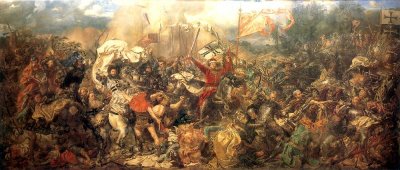
Above - next paining about Grunwald battle
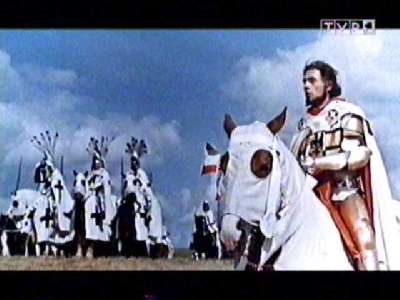
Above - shot from the Polish movie about Battle of Grunwald
Read me soon, please:)

